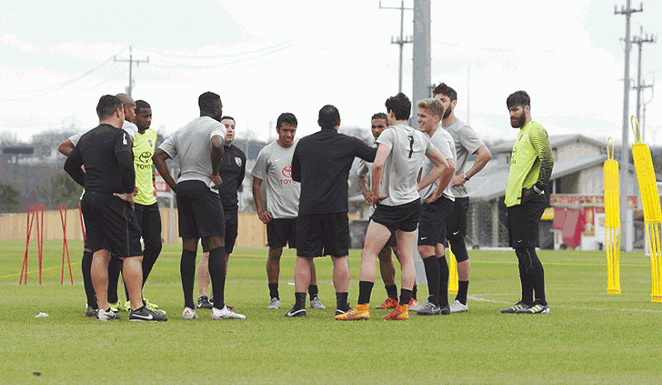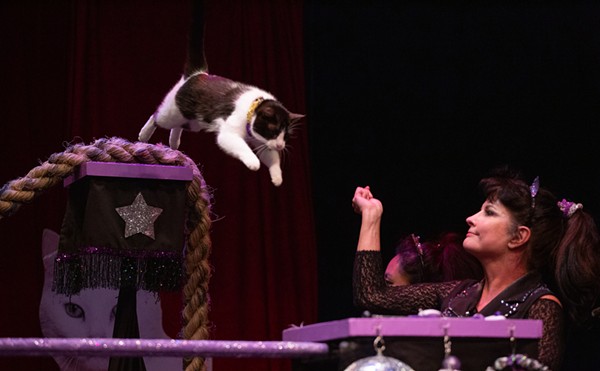When new soccer club San Antonio FC holds its home opener next month, many parts of the game will look exactly as they did when the San Antonio Scorpions were the pro soccer squad in town.
Even though the Scorpions are no more, the game will still be played at Toyota Field. The loudest chants and cheers will blare from the same sections of the stadium. Even a few of the players who fans first knew as Scorpions will take the field for SAFC.
But there will be at least one key difference. When the club kicks off, it will do so in the United Soccer League — a growing league that's quite a bit different from the North American Soccer League, which local soccer fans grew accustomed to during the Scorpions' four seasons.
When the City of San Antonio, Bexar County and Spurs Sports and Entertainment purchased Toyota Field from local developer and philanthropist Gordon Hartman, they did so with the long-term goal of bringing Major League Soccer to San Antonio. The Spurs group determined that the USL was the best platform to do that.
The league has a direct link with MLS, making it an attractive option for SAFC's goals, the club's managing director Tim Holt said.
"It's the strongest American soccer league below and in support of MLS," said Holt. "The link with MLS has been a major asset for the league both in terms of its growth, credibility and exposure. I think it's helped [the league] to attract some really talented players."
Although the on-field products of the USL and NASL look quite similar (minor league soccer is minor league soccer, after all), the structure of the two leagues is considerably different, and could have major implications for SAFC's future ambitions.
The USL is growing rapidly. It started in 2010 and over half of its 29 teams were founded in the last two years, including independent stand-alone teams such as SAFC, clubs that are affiliated with MLS, as well as clubs directly owned by MLS teams.
MLS-owned or affiliated teams represent the majority of the league. The agreements allow the MLS clubs to use the USL much like minor league teams in other sports: They can send players down to get more experience, to rehab from injuries or to scout prospective athletes. That means that the makeup of a club on any given night can change drastically.
"There's different philosophies to each organization," said SAFC head coach Darren Powell. "So it's a very interesting league, very intriguing league. One that is going to be very hard to predict. ... That's what's very exciting and very unique about the league."
Some of the clubs to most recently join MLS, including the Portland Timbers, Montreal Impact, Vancouver Whitecaps, Seattle Sounders and Orlando City SC first started in the USL before making the jump to the big leagues.
"There's a proven pathway which has been developed," Holt said. "We think [USL] is the best platform in order to be able to build this thing up to a Major League Soccer level."
A Step Down?
When Spurs Sports and Entertainment announced that its new team would play in the USL, some fans chafed at the notion of playing in a Division III league – which it is, according to the structure of the United States Soccer Federation. Some viewed it as a step down, as the NASL is a Division II league.
But the Division III designation doesn't mean that the USL is a downgrade in quality or competitiveness from the NASL. Recent results suggest just the opposite, in fact.
During the third round of the 2015 U.S. Open Cup, an annual American soccer tournament open to teams at all levels, there were seven matches between USL and NASL teams. The USL won six, including a victory by the Austin Aztex over the San Antonio Scorpions.
"It's actually dramatically flipped the opposite way of how you might think — that Division II would dominate Division III," Holt said. "That's in no way disparaging toward the NASL, which is a good league. I just don't think there's any functional difference on the field."
When recruiting players to fill out the roster, Holt and Powell said that they'd often compete against NASL teams and overseas clubs, in addition to other USL squads. And they've recruited a young team, with only a rare few players over the age of 30. Some of them have MLS experience, others have played overseas, most come from the USL or NASL.
As a stand-alone club, SAFC can't rely on a parent club in the MLS to send players down. Instead, they hope that the players they recruit now could be the core of a group that makes the jump to the major leagues a couple years down the road.
"What we're selling is an opportunity to be part of a club that's building something special for the future," Holt said. "There's a hunger with these younger players who are trying to fill in the front end of their pro careers and try to establish something."
SAFC's first home game is Saturday, April 9, against the Kansas City-based side Swope Park Rangers.


















